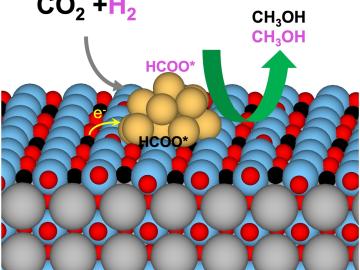Filter News
Area of Research
- Advanced Manufacturing (5)
- Biological Systems (4)
- Biology and Soft Matter (3)
- Building Technologies (3)
- Chemical and Engineering Materials (2)
- Chemistry and Physics at Interfaces (5)
- Clean Energy (69)
- Climate and Environmental Systems (6)
- Computational Biology (1)
- Computational Chemistry (4)
- Computational Engineering (1)
- Computer Science (1)
- Earth Sciences (1)
- Energy Frontier Research Centers (6)
- Fossil Energy (1)
- Fuel Cycle Science and Technology (1)
- Functional Materials for Energy (8)
- Fusion and Fission (1)
- Geographic Information Science and Technology (1)
- Isotopes (1)
- Materials (74)
- Materials for Computing (7)
- Materials Synthesis from Atoms to Systems (8)
- Materials Under Extremes (5)
- National Security (2)
- Neutron Data Analysis and Visualization (2)
- Neutron Science (22)
- Nuclear Science and Technology (12)
- Nuclear Systems Technology (1)
- Quantum Condensed Matter (2)
- Renewable Energy (3)
- Sensors and Controls (1)
- Supercomputing (37)
- Transportation Systems (4)
News Type
Date
News Topics
- 3-D Printing/Advanced Manufacturing (8)
- Advanced Reactors (3)
- Artificial Intelligence (18)
- Big Data (5)
- Bioenergy (9)
- Biology (9)
- Biomedical (5)
- Biotechnology (4)
- Buildings (10)
- Chemical Sciences (9)
- Clean Water (3)
- Climate Change (14)
- Composites (3)
- Computer Science (17)
- Critical Materials (6)
- Decarbonization (15)
- Education (1)
- Emergency (1)
- Energy Storage (7)
- Environment (19)
- Exascale Computing (5)
- Fossil Energy (2)
- Frontier (5)
- Fusion (5)
- Grid (5)
- High-Performance Computing (12)
- Isotopes (7)
- ITER (1)
- Machine Learning (7)
- Materials (10)
- Materials Science (10)
- Mathematics (1)
- Mercury (2)
- Microscopy (2)
- Nanotechnology (2)
- National Security (12)
- Net Zero (4)
- Neutron Science (10)
- Nuclear Energy (7)
- Partnerships (8)
- Physics (2)
- Polymers (3)
- Quantum Computing (7)
- Quantum Science (9)
- Security (2)
- Simulation (10)
- Space Exploration (3)
- Statistics (2)
- Summit (4)
- Sustainable Energy (11)
- Transportation (8)
Media Contacts

A group of high school graduates and community college students visited ORNL to meet staff and find out just what goes on at a DOE national laboratory. The Job Shadow Day was arranged by tnAchieves, a student support organization that works to increase higher educational opportunities for students across Tennessee through scholarships and mentorship.

Scientists have uncovered the properties of a rare earth element that was first discovered 80 years ago at the very same laboratory, opening a new pathway for the exploration of elements critical in modern technology, from medicine to space travel.

Researchers set a new benchmark for future experiments making materials in space rather than for space. They discovered that many kinds of glass have similar atomic structure and arrangements and can successfully be made in space. Scientists from nine institutions in government, academia and industry participated in this 5-year study.

Students from the first class of ORNL and Pellissippi State Community College's joint Chemical Radiation Technology Pathway toured isotope facilities at ORNL.

Researchers tackling national security challenges at ORNL are upholding an 80-year legacy of leadership in all things nuclear. Today, they’re developing the next generation of technologies that will help reduce global nuclear risk and enable safe, secure, peaceful use of nuclear materials, worldwide.

A team of scientists led by ORNL found an unconventional way to improve catalysts made of more than one material. The solution demonstrates a path to designing catalysts with greater activity, selectivity and stability.
ORNL drone and geospatial team becomes first to map the Coca River in the Amazon basin as erosion and sediment threaten Ecuador’s lands.

Researchers at ORNL are developing battery technologies to fight climate change in two ways, by expanding the use of renewable energy and capturing airborne carbon dioxide.

A team of researchers including a member of the Quantum Science Center at ORNL has published a review paper on the state of the field of Majorana research. The paper primarily describes four major platforms that are capable of hosting these particles, as well as the progress made over the past decade in this area.

Researchers at the Department of Energy’s Oak Ridge National Laboratory met recently at an AI Summit to better understand threats surrounding artificial intelligence. The event was part of ORNL’s mission to shape the future of safe and secure AI systems charged with our nation’s most precious data.




